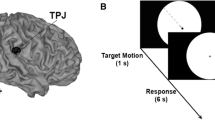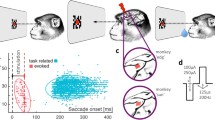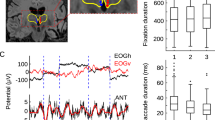Abstract
Transcranial magnetic stimulation (TMS) is increasingly used to perturb targeted human brain sites non-invasively, to test for causal effects on performance of cognitive tasks. TMS might also be used in non-human primates to complement invasive work and compare with human studies. Here, we targeted the frontal eye fields (FEF) in two macaques with a continuous theta-burst (cTBS) protocol, testing the impact on visually guided saccades. After unilateral cTBS over the FEF in either hemisphere, a small (mean 7 ms) but highly consistent decrease in saccadic reaction times (RTs) was observed. Lower latencies arose for saccades both contra- and ipsilateral to the stimulated FEF after cTBS. These results provide the first demonstration that TMS can be used to affect saccadic behavior in non-human primates. The unexpectedly bilateral impact on RTs may reflect an impact on ‘fixation’ neurons in the FEF and/or transcallosal modulation of both FEFs induced by unilateral cTBS. In either case, this study demonstrates a clear behavioral effect induced by TMS in awake behaving monkeys performing a cognitive task. This opens new opportunities for investigating the causal roles of targeted brain areas in behavior, for measuring physiological consequences of TMS in the primate brain, and ultimately for human–monkey comparisons.




Similar content being viewed by others
References
Allen EA, Pasley BN, Duong T, Freeman RD (2007) Transcranial magnetic stimulation elicits coupled neural and hemodynamic consequences. Science 317(5846):1918–1921
Amaya F, Paulus W, Treue S, Liebetanz D (2010) Transcranial magnetic stimulation and PAS-induced cortical neuroplasticity in the awake rhesus monkey. Clin Neurophysiol 121(12):2143–2151
Baker SN, Olivier E, Lemon RN (1995) Task-related variation in corticospinal output evoked by transcranial magnetic stimulation in the macaque monkey. J Physiol 488(Pt 3):795–801
Barker AT, Jalinous R, Freeston IL (1985) Non-invasive magnetic stimulation of human motor cortex. Lancet 1(8437):1106–1107
Bizzi E (1968) Discharge of frontal eye field neurons during saccadic and following eye movements in unanesthetized monkeys. Exp Brain Res 6(1):69–80
Bruce CJ, Goldberg ME, Bushnell MC, Stanton GB (1985) Primate frontal eye fields. II. Physiological and anatomical correlates of electrically evoked eye movements. J Neurophysiol 54(3):714–734
Cazzoli D, Wurtz P, Muri RM, Hess CW, Nyffeler T (2009) Interhemispheric balance of overt attention: a theta burst stimulation study. Eur J Neurosci 29(6):1271–1276
Chen R, Classen J, Gerloff C, Celnik P, Wassermann EM, Hallett M, Cohen LG (1997) Depression of motor cortex excitability by low-frequency transcranial magnetic stimulation. Neurology 48(5):1398–1403
Di Lazzaro V, Pilato F, Saturno E, Oliviero A, Dileone M, Mazzone P, Insola A, Tonali PA, Ranieri F, Huang YZ, Rothwell JC (2005) Theta-burst repetitive transcranial magnetic stimulation suppresses specific excitatory circuits in the human motor cortex. J Physiol 565(Pt 3):945–950
Dias EC, Segraves MA (1999) Muscimol-induced inactivation of monkey frontal eye field: effects on visually and memory-guided saccades. J Neurophysiol 81(5):2191–2214
Fitzgerald PB, Fountain S, Daskalakis ZJ (2006) A comprehensive review of the effects of rTMS on motor cortical excitability and inhibition. Clin Neurophysiol 117(12):2584–2596
Gamboa OL, Antal A, Moliadze V, Paulus W (2010) Simply longer is not better: reversal of theta burst after-effect with prolonged stimulation. Exp Brain Res 204(2):181–187
Gaymard B, Ploner CJ, Rivaud S, Vermersch AI, Pierrot-Deseilligny C (1998a) Cortical control of saccades. Exp Brain Res 123(1–2):159–163
Gaymard B, Rivaud S, Cassarini JF, Dubard T, Rancurel G, Agid Y, Pierrot-Deseilligny C (1998b) Effects of anterior cingulate cortex lesions on ocular saccades in humans. Exp Brain Res 120(2):173–183
Gilio F, Rizzo V, Siebner HR, Rothwell JC (2003) Effects on the right motor hand-area excitability produced by low-frequency rTMS over human contralateral homologous cortex. J Physiol 551(Pt 2):563–573
Guitton D, Buchtel HA, Douglas RM (1985) Frontal lobe lesions in man cause difficulties in suppressing reflexive glances and in generating goal-directed saccades. Exp Brain Res 58(3):455–472
Henik A, Rafal R, Rhodes D (1994) Endogenously generated and visually guided saccades after lesions of the human frontal eye fields. J Cogn Neurosci 6:400–411
Huang YZ, Edwards MJ, Rounis E, Bhatia KP, Rothwell JC (2005) Theta burst stimulation of the human motor cortex. Neuron 45(2):201–206
Izawa Y, Suzuki H, Shinoda Y (2004) Suppression of visually and memory-guided saccades induced by electrical stimulation of the monkey frontal eye field. II. Suppression of bilateral saccades. J Neurophysiol 92(4):2261–2273
Izawa Y, Suzuki H, Shinoda Y (2009) Response properties of fixation neurons and their location in the frontal eye field in the monkey. J Neurophysiol 102(4):2410–2422
Kobayashi M, Pascual-Leone A (2003) Transcranial magnetic stimulation in neurology. Lancet Neurol 2(3):145–156
Maier MA, Olivier E, Baker SN, Kirkwood PA, Morris T, Lemon RN (1997) Direct and indirect corticospinal control of arm and hand motoneurons in the squirrel monkey (Saimiri sciureus). J Neurophysiol 78(2):721–733
Moliadze V, Zhao Y, Eysel U, Funke K (2003) Effect of transcranial magnetic stimulation on single-unit activity in the cat primary visual cortex. J Physiol 553(Pt 2):665–679
Muellbacher W, Ziemann U, Boroojerdi B, Hallett M (2000) Effects of low-frequency transcranial magnetic stimulation on motor excitability and basic motor behavior. Clin Neurophysiol 111(6):1002–1007
Muri RM, Nyffeler T (2008) Neurophysiology and neuroanatomy of reflexive and volitional saccades as revealed by lesion studies with neurological patients and transcranial magnetic stimulation (TMS). Brain Cogn 68(3):284–292
Muri RM, Hess CW, Meienberg O (1991) Transcranial stimulation of the human frontal eye field by magnetic pulses. Exp Brain Res 86(1):219–223
Muri RM, Gaymard B, Rivaud S, Vermersch A, Hess CW, Pierrot-Deseilligny C (2000) Hemispheric asymmetry in cortical control of memory-guided saccades. A transcranial magnetic stimulation study. Neuropsychologia 38(8):1105–1111
Nelissen K, Vanduffel W (2011) Grasping-related functional MRI brain responses in the macaque monkey. J Neurosci (in press)
Nyffeler T, Wurtz P, Luscher HR, Hess CW, Senn W, Pflugshaupt T, von Wartburg R, Luthi M, Muri RM (2006a) Repetitive TMS over the human oculomotor cortex: comparison of 1-Hz and theta burst stimulation. Neurosci Lett 409(1):57–60
Nyffeler T, Wurtz P, Pflugshaupt T, von Wartburg R, Luthi M, Hess CW, Muri RM (2006b) One-Hertz transcranial magnetic stimulation over the frontal eye field induces lasting inhibition of saccade triggering. Neuroreport 17(3):273–275
Nyffeler T, Wurtz P, Luscher HR, Hess CW, Senn W, Pflugshaupt T, von Wartburg R, Luthi M, Muri RM (2006c) Extending lifetime of plastic changes in the human brain. Eur J Neurosci 24(10):2961–2966
Nyffeler T, Cazzoli D, Hess CW, Muri RM (2009) One session of repeated parietal theta burst stimulation trains induces long-lasting improvement of visual neglect. Stroke 40(8):2791–2796
Olk B, Chang E, Kingstone A, Ro T (2006) Modulation of antisaccades by transcranial magnetic stimulation of the human frontal eye field. Cereb Cortex 16(1):76–82
Pasley BN, Allen EA, Freeman RD (2009) State-dependent variability of neuronal responses to transcranial magnetic stimulation of the visual cortex. Neuron 62(2):291–303
Pierrot-Deseilligny C, Rivaud S, Penet C, Rigolet MH (1987) Latencies of visually guided saccades in unilateral hemispheric cerebral lesions. Ann Neurol 21(2):138–148
Plewnia C, Bartels M, Gerloff C (2003) Transient suppression of tinnitus by transcranial magnetic stimulation. Ann Neurol 53(2):263–266
Prime SL, Vesia M, Crawford JD (2010) TMS over human frontal eye fields disrupts trans-saccadic memory of multiple objects. Cereb Cortex 20(4):759–772
Ro T, Cheifet S, Ingle H, Shoup R, Rafal R (1999) Localization of the human frontal eye fields and motor hand area with transcranial magnetic stimulation and magnetic resonance imaging. Neuropsychologia 37(2):225–231
Ro T, Farne A, Chang E (2002) Locating the human frontal eye fields with transcranial magnetic stimulation. J Clin Exp Neuropsychol 24(7):930–940
Ruff CC, Blankenburg F, Bjoertomt O, Bestmann S, Freeman E, Haynes JD, Rees G, Josephs O, Deichmann R, Driver J (2006) Concurrent TMS-fMRI and psychophysics reveal frontal influences on human retinotopic visual cortex. Curr Biol 16(15):1479–1488
Segraves MA, Goldberg ME (1987) Functional properties of corticotectal neurons in the monkey’s frontal eye field. J Neurophysiol 58(6):1387–1419
Sommer MA, Tehovnik EJ (1997) Reversible inactivation of macaque frontal eye field. Exp Brain Res 116(2):229–249
Sommer MA, Wurtz RH (2000) Composition and topographic organization of signals sent from the frontal eye field to the superior colliculus. J Neurophysiol 83(4):1979–2001
Tehovnik EJ, Sommer MA, Chou IH, Slocum WM, Schiller PH (2000) Eye fields in the frontal lobes of primates. Brain Res Brain Res Rev 32(2–3):413–448
Terao Y, Ugawa Y, Sakai K, Miyauchi S, Fukuda H, Sasaki Y, Takino R, Hanajima R, Furubayashi T, Putz B, Kanazawa I (1998) Localizing the site of magnetic brain stimulation by functional MRI. Exp Brain Res 121(2):145–152
Valero-Cabre A, Payne BR, Rushmore J, Lomber SG, Pascual-Leone A (2005) Impact of repetitive transcranial magnetic stimulation of the parietal cortex on metabolic brain activity: a 14C–2DG tracing study in the cat. Exp Brain Res 163(1):1–12
van Donkelaar P, Lin Y, Hewlett D (2009) The human frontal oculomotor cortical areas contribute asymmetrically to motor planning in a gap saccade task. PLoS One 4(9):e7278
Van Ettinger-Veenstra HM, Huijbers W, Gutteling TP, Vink M, Kenemans JL, Neggers SF (2009) fMRI-guided TMS on cortical eye fields: the frontal but not intraparietal eye fields regulate the coupling between visuospatial attention and eye movements. J Neurophysiol 102(6):3469–3480
Vanduffel W, Fize D, Mandeville JB, Nelissen K, Van Hecke P, Rosen BR, Tootell RB, Orban GA (2001) Visual motion processing investigated using contrast agent-enhanced fMRI in awake behaving monkeys. Neuron 32(4):565–577
Wardak C, Vanduffel W, Orban GA (2010) Searching for a salient target involves frontal regions. Cereb Cortex 20(10):2464–2477
Acknowledgments
The authors are indebted to A. Coeman, C. Fransen, M. Depaep, W. Depuydt, M. Deforche, P. Kayenbergh, G. Meulemans, C. Van Eupen, S. Verstraeten for help with the experiments. The work was supported by Human Frontiers Science Program (HFSPO RGP7/2007), Medical Foundation Queen Elisabeth (2008-10), Inter University Attraction Pole6/29, Program Financing 2010-15, Fonds voor Wetenschappelijk onderzoek, VLaanderen (FWO) G.0622.08; FWO G.0593.09, National Science Foundation BCS-0745436 and European Union (EU) grant (FP7 HEALTH-F2-2008-200728), BrainSynch. JD is a Royal Society Anniversary Research Professor. AG has an Aspirant fellowship of FWO-Flanders.
Author information
Authors and Affiliations
Corresponding author
Additional information
A. Gerits and C. C. Ruff these authors contributed equally.
A comment to this article is available at http://dx.doi.org/10.1007/s00221-011-2840-7.
Electronic supplementary material
Below is the link to the electronic supplementary material.
Supplementary material 1 (MPG 8480 kb)
221_2011_2710_MOESM2_ESM.eps
Fig. S1 Schematic drawing of a monkey-TMS setup based on a picture. The left panel of the figure shows the D25mm TMS coil with its center positioned above the monkey’s right FEF. The position was determined using the brainsight neuronavigation system. The head of the monkey was fixed to the chair. In the right panel the size of TMS coil in respect to the monkey’s head size can be observed. (EPS 10892 kb)
Rights and permissions
About this article
Cite this article
Gerits, A., Ruff, C.C., Guipponi, O. et al. Transcranial magnetic stimulation of macaque frontal eye fields decreases saccadic reaction time. Exp Brain Res 212, 143–152 (2011). https://doi.org/10.1007/s00221-011-2710-3
Received:
Accepted:
Published:
Issue Date:
DOI: https://doi.org/10.1007/s00221-011-2710-3




